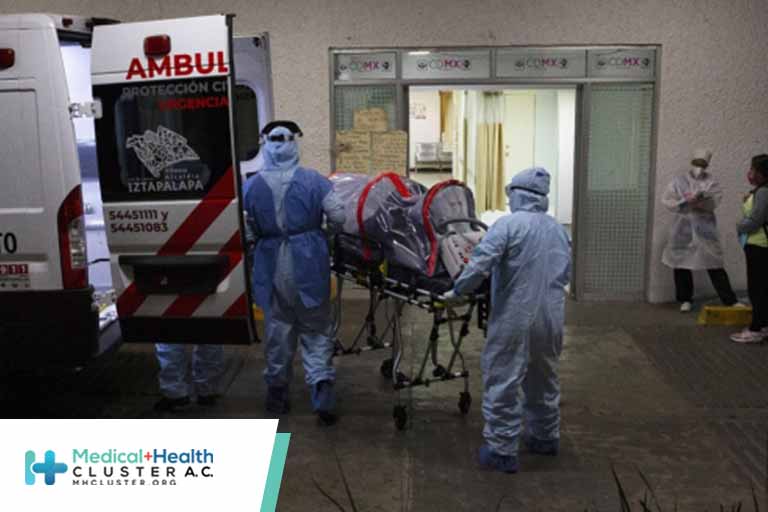En respuesta al anuncio del alcalde Ismael Burgueño Ruiz sobre...
Leer más
Ischemic Stroke, Inflammation, and Endotheliopathy in COVID-19 Patients

Background and Purpose:
Reports indicate an increased risk of ischemic stroke during coronavirus disease 2019 (COVID-19) infection. We aimed to identify patients with COVID-19 and ischemic stroke and explore markers of inflammation, hypercoagulability, and endotheliopathy, a structural and functional disturbance of the vascular endothelium due to a stressor.
Methods:
This was a retrospective, observational cohort study comparing acute ischemic stroke patients with and without COVID-19 across 3 hospitals. Timing of stroke onset during COVID-19 course and markers of inflammation, hypercoagulability, and endothelial activation were evaluated by COVID-19 status and stroke cause.
Results:
Twenty-one patients with ischemic stroke were diagnosed with COVID-19 during the study period. Patients with COVID-19 had a similar age and burden of vascular risk factors compared with the control cohort (n=168). We identified a temporal correlation between stroke onset and the peak of acute phase reactants, including CRP (C-reactive protein), ferritin, and d-dimer. In subsets of patients with labs available, embolic stroke of undetermined source was associated with elevated IL (interleukin)-6 (median, 171 [interquartile range, 13–375] versus 8 [4–11], P<0.01) and sIL (soluble IL)-2 receptor (1972 [1525–4720] versus 767 [563–1408.5], P=0.05) levels. Stroke patients with COVID-19 demonstrated elevated levels of endothelial activation markers compared with non-COVID-19 stroke controls (median von Willebrand activity 285.0% [interquartile range, 234%–382%] versus 150% [128%–183%], P=0.034; von Willebrand antigen 330.0% [265%–650%] versus 152% [130%–277%], P=0.007, and factor VIII 301% [289%–402%] versus 49% [26%–94%], P<0.001).
Conclusions:
Ischemic stroke in patients with COVID-19 is associated with endotheliopathy and a systemic inflammatory response in patients with vascular risk factors. Further research evaluating endothelial and inflammatory markers in the setting of ischemic stroke and COVID-19 in larger, prospective cohorts is needed to validate the findings.
Novel coronavirus disease 2019 (COVID-19) secondary to severe acute respiratory syndrome coronavirus 2 is associated with a diverse array of neurological complications, including ischemic stroke.1–4 Postulated mechanisms of ischemic stroke in COVID-19 include hypercoagulability and endothelial injury,5 although laboratory evidence of these pathways is sparse in patients with stroke. We compare clinical and laboratory characteristics of contemporaneous ischemic stroke patients with and without COVID-19. We analyze relationships between levels of serological markers and the timing and subtype of ischemic stroke among patients with COVID-19.
Methods
Full methodological details are provided in the Expanded Materials and Methods (Material in the Data Supplement). The data set compiled for this study will be made available by the corresponding author upon reasonable request. This was a retrospective, observational study of individuals with ischemic stroke and COVID-19 between March 1 and June 6, 2020, across 2 primary stroke centers and 1 comprehensive stroke center in Connecticut. Stroke patients with COVID-19 (n=21) were compared with stroke patients without COVID-19 (n=168) who presented in an overlapping time period. Severe acute respiratory syndrome coronavirus 2 infection was diagnosed by nasopharyngeal reverse transcriptase polymerase chain reaction. We analyzed data from a subset of patients for whom levels of acute phase reactants, inflammation, and hypercoagulability were collected for clinical care; temporal patterns in these laboratory values were analyzed if collected serially in the COVID-19 group (n=18) and analyzed for associations with stroke onset and cause. Laboratory studies for endothelial injury were analyzed on frozen plasma samples from both COVID-19 (n=8) and a subgroup of control patients who donated blood for research immediately before the pandemic (n=13) using the same clinical laboratory platform. The Institutional Review Board approved the study and all patients were cross-referenced with the institution’s research exemption database.
Results
Patient Characteristics
There were 21 stroke patients with COVID-19 and 168 without COVID-19 included in the study. Clinical characteristics are shown in Table 1. There was a significantly higher proportion of stroke patients with COVID-19 who were Hispanic in comparison to the control patients. Traditional stroke risk factors were similar between stroke patients with COVID-19 and control patients. There was no difference in large vessel occlusion or stroke cause between groups. Patients with COVID-19 were significantly less likely to receive tPA (tissue-type plasminogen activator) during the acute pandemic. Among the stroke patients with COVID-19, the median time from COVID-19 symptom onset to ischemic stroke was 7 (interquartile range, 0–13) days. Five patients were asymptomatic from COVID-19 when presenting with a stroke. Nearly 43% developed an additional nonstroke thrombosis (Table I in the Data Supplement).
Read complete: https://www.ahajournals.org/doi/10.1161/STROKEAHA.120.031971
Créditos: Comité científico Covid





